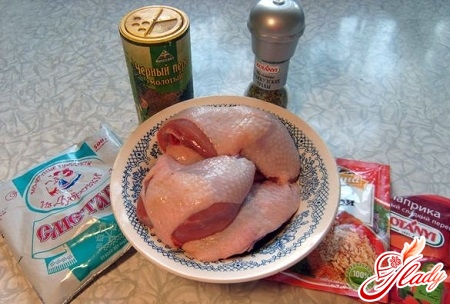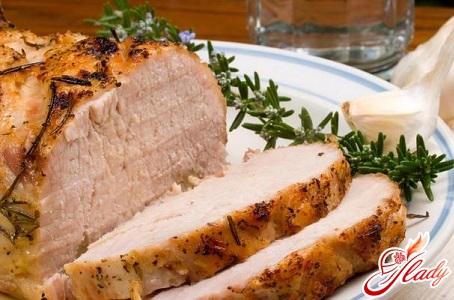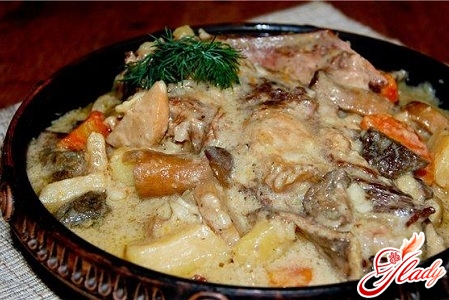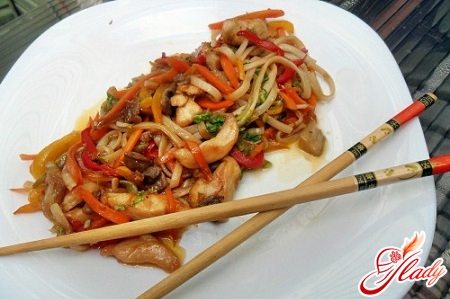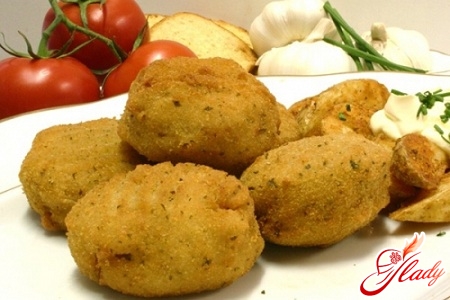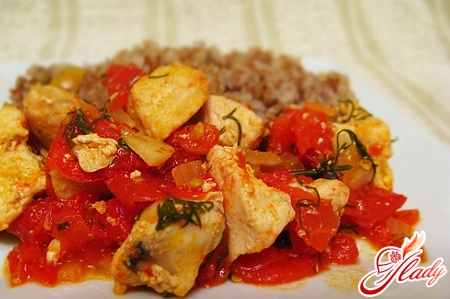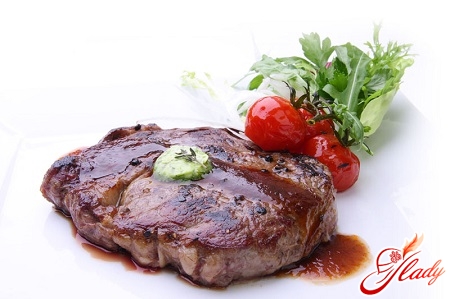
Another F. Engels once said that a man could not become a man without meat. May vegetarians forgive us, but it's hard to argue with this. Meat is a supplier of the most important nutrients necessary for the normal functioning of the human body, first of all, a full-fledged protein, more rich in essential amino acids than vegetable proteins, which, moreover, is more easily digested and promotes a more complete assimilation of plant proteins. Meat contains so much needed mineral substances and vitamins. For example, vitamin B, the lack of which leads to serious diseases, is found only in meat and other products of animal origin. Today we will talk not just about meat, but about the ideal meat, how to cook a beef steak. It is the steak is one of their most ancient dishes, the recipe of which has been given to the family. We will not go into the story of the origin of the steak, especially since it is full of the legend, beginning with the rituals of sacrifice in ancient Rome and ending with the ranking of steak in American culture. The only thing that remains true is that after thousands of years the steak has turned into a kind of cult, beginning with the choice of meat and ending with its serving to the table. Steak is not an everyday meal. The recipe for steak cooking assumes special conditions, and, not least, a special atmosphere. Often a steak is confused with an ordinary chop or meat in French, mistakenly thinking that this is an ordinary piece of meat roasted on an open fire or in a skillet. What's easier - take a piece of meat and fry a beef steak. But only at first glance the preparation of this dish seems a simple task. The recipe is really not that complicated. But not everything is so simple. We will tell you how to properly prepare a steak at home, armed with several rules. What is needed to make the perfect beef steak - delicious, fragrant and juicy?
So, the first is the right meat
The steak favorite is a beef steak,ideal - from the meat of young bull-calves. The classic recipe assumes the use of meat from the bulls of Hereford or Agnus. However, the taste of the future steak depends not only or not so much on the breed as on the way of fattening animals - grass or grain. Because the grain is rich in protein, this food contributes to the formation in the muscle fibers of thin fat layers. Such meat is also called marble. It is more tender, although less fragrant, than meat of animals grown on grass fattening. The steak, translated from English, sounds like a "tenderloin", that is, it is a rather thick piece of meat (a portioned piece must be at least 3 cm thick) cut strictly in the transverse direction from those parts of the animal carcass whose muscles were not involved in the motor activity. It is this meat is considered the most tender. However, there are few such unrefined parts in the carcass of the animal (not more than 7-10%), and that is why the beef steak is considered a delicacy. For example, it's impossible to cook a decent steak from the pulp of the sternum or part of the leg, no matter how magical the recipe is. The most suitable for the beef steak is the meat from the back and the loin portion. Choose those parts of the carcass that do not have tendons and powerful muscles. Depending on which part of the carcass the piece was taken from, in a modern steak culture several basic types of beef steak are isolated. 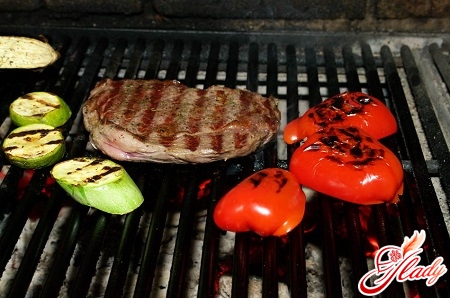
What are the types of steak?
Rib-steak-steak, the basis for which isa piece of meat from the subscapular part of the carcass, which has a lot of fatty veins, best suiting the juiciness of the dish. Club-steak - a piece of meat for such a steak is cut out on a segment of the thick edge of the longest dorsal muscle, has a small costal bone. Thibone steak (or steak on a T-shaped bone) - a section of the carcass is used in the region of the thin edge of the longest dorsal muscle and the thin margin of the notch, on the border between the dorsal and lumbar parts. The piece cut in this way consists simultaneously of two types of steak meat - a filet-mignon on one side and a T-shaped bone on the other. Porterhouse steak and striploin steak are steaks from the lumbar part of the back, but in the first case a piece of meat is taken in the area of the thick edge of the tenderloin, and in the second case, in the area of the head part of the tenderloin. Roundram-steak - for this steak is used the upper piece of the hip part of the carcass. Fillet mignon - steak is not for meat lovers "with blood", because for its preparation the most tender and lean meat is used - a transverse thin section of the central part of the fillet sirloin. Chateaubriand - is prepared from the thick edge of the central part of the beef tenderloin. In its essence, this is a large filet-mignon, which is put on the plate in the finished form in length, after which it is cut into pieces. Tornedos - small pieces are used from the thin edge of the central part of the tenderloin, usually for medallions. Skirt steak - to make this steak, take a piece of meat from the flank (steak is not the most delicate, but very tasty).
Basic rules for choosing meat
When choosing meat, remember that the color should bebe bright red, from red to dark red, but not pink or burgundy. Meat for a beef steak should be mature, but not old and not young. The recipe for success is do not use steamed beef. Svezhesrezannym with carcass slices of meat will have to rest, withstood them in the refrigerator for a couple of days at a temperature of +2 ° C, until they flow out of the blood. During this time, the enzymes in the meat will gradually loosen the muscle tissue, and the beef will become softer, tender and juicy. When choosing meat, pay special attention to its elasticity, the meat should be fairly dense in composition. To determine if the steak will be soft, press down on the raw meat: if a deep hole forms during the immersion of the finger, which after smoothing is smoothly leveled, assuming its original position, the meat is good. Not too fresh meat resembles a sponge, when pressing a finger on it with a finger the pit does not straighten. 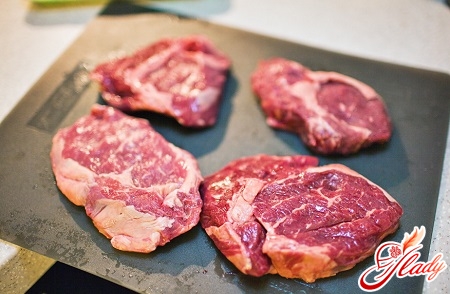
Chilled or frozen?
Experienced cooks say that with the rightDefrosting is difficult to distinguish to taste, what kind of meat was taken to prepare the steak - chilled or frozen. It is enough just to defrost the meat correctly, observing some basic rules: do not thaw meat in any way either at room temperature, or in the microwave (even in the defrosting mode), or under a stream of cold (and even hotter) water. With such an emergency defrost, the crystals of the frozen liquid will simply tear the delicate fibers of the meat. Defrosting meat is a slow and natural process that should take place at a temperature close to 0 ° C, if possible - in the main compartment of the refrigerator. And even if it takes you a lot of time, this is how meat will best preserve its nutritional value.
Let's Get Ready
Meat must be thoroughly cleaned, stronglycut off all films and upper tendons from it, then wash, preferably with a brush, after which it should be dried in a colander or on a cloth for 10 minutes. The recipe for correct cutting is simple. Slices of meat for a beef steak should be sliced strictly across the fibers. This podzdelya meat will chew the gin in the process of cooking povnomerno through the glass, quickly and evenly napegovaya meat before the necessary temperature. Pieces should be in thickness from 3 to 5 cm. To prepare a steak in a frying pan it will be enough to be 3 cm, and when cooking on charcoal the thickness of a piece can reach 5 cm. Remember that meat for a steak is by no means beaten, since it is so loses not only its structure, but also all the juices. In addition to the meat itself, you need to stock up with any vegetable oil (preferably olive oil) and a set of spices or herbs to make a beef steak. Spices will enable you to enjoy the true taste of meat. In order for the meat to turn out to be airy-tender and bright-juicy, it should be pre-marinated. There are many ways to marinate meat for a beef steak. This process lasts about 10-12 hours. The dishes for pickling should be porcelain, glass or ceramic, necessarily with a tight fitting lid. The traditional recipe for marinade is a mixture of olive oil, wine vinegar (or lemon juice), soy sauce, salt and seasonings. Important advice: when preparing marinade salt use in small amounts, so the meat will not lose its juiciness and will get more delicious. It is better to salt the steak in the process of frying, or even at the very end. 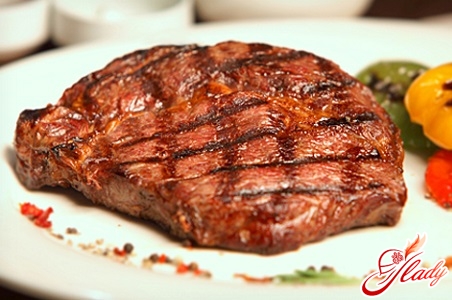
Choose the right dishes
The second rule for getting the perfect steakfrom beef, not counting the choice of meat, is the choice of dishes. For cooking you will need a frying pan. Ideally, it should be a special grill pan. However, an ordinary "grandmother's" cast-iron frying pan, which is sure to be found in every kitchen, is quite suitable. Electric cookware for steak cooking does not quite fit, because in this case it will be more difficult for you to control the required temperature. The frying pan must be well heated. The oil pours out on the already heated dishes. Remember that the frying pan has warmed to the desired temperature in the event that when stacking on it steak gives a characteristic hiss. When the frying pan hits the frying pan, a crusty crust forms on the meat, which prevents the juice from flowing and thanks to which the steak remains juicy. If a piece of meat is thick enough, you can use a special forceps to fix the piece perpendicular to the frying pan, thus sealing the edges of the steak. To get the perfect steak, do not fry more than one piece at a time in one pan. As the meat is laid, the frying pan will be cooled, the crust on the surface of the meat will not form for a long time, the meat, respectively, loses the juices, and the steak will turn out to be dry, hard and not tasty. During cooking, you must carefully monitor the oil. If it begins to foam, it is necessary to increase the fire urgently, in order to avoid boiling of the juice, which must be left inside the steak, behind a crusty crust. Using one recipe, you can cook at least three different beef steaks that differ in degree of juiciness. Depending on the duration of meat retention in the pan, the steaks may have different degrees of roasting. 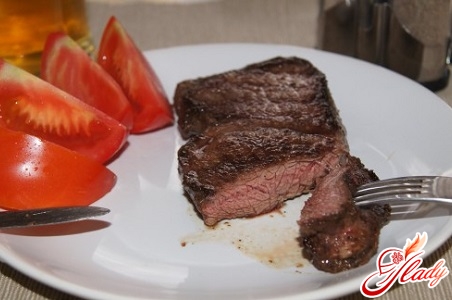
There are three basic types of roasting
The degree of Rare, or steak with blood, is obtained whenduration of roasting 4 minutes, two on each side. The finished steak has a temperature of between 45 ° C and 50 ° C. On the meat in this case, only the crust has time to appear. The degree of frying Medium is typical for medium-seasoned meat with pinkish meat juice, the duration of roasting is about 8-10 minutes. The temperature inside the steak ranges from 55 ° C to 60 ° C. With a degree of Medium, the ideal tenderness and juiciness of meat is achieved. The degree of roasting Medium Wеll is achieved as a result of roasting the steak for 8 minutes in a pan and 4 minutes in the oven, heated to the maximum temperature. Meat in this case is obtained well roasted, with a temperature inside of 65 ° C to 70 ° C. Readiness of a steak is easy to check by pressing a finger on it. The steak with blood will be soft, well roasted - firm, and a steak of average degree of roasting represents something average. And the last rule, which applies equally to all meat dishes - is to remove meat from fire, allow it to "rest", ripen for about 5-10 minutes, so that all the juices that were released during frying can evenly spread throughout the piece. If you start cutting meat at once, the juice will flow out and the steak will turn dry. After the finished meat "rested", it can be served to the table on a warmed plate. As a side dish to a steak, garlic bread or vegetables in any form, but in a small amount, is perfect. Remember that the steak is the king on your table, do not distract him from attention with a side dish. Well, to top it off, create a suitable atmosphere - put a bottle of dry red wine. Now you know the recipe for the perfect dish. Enjoy the perfect evening!




